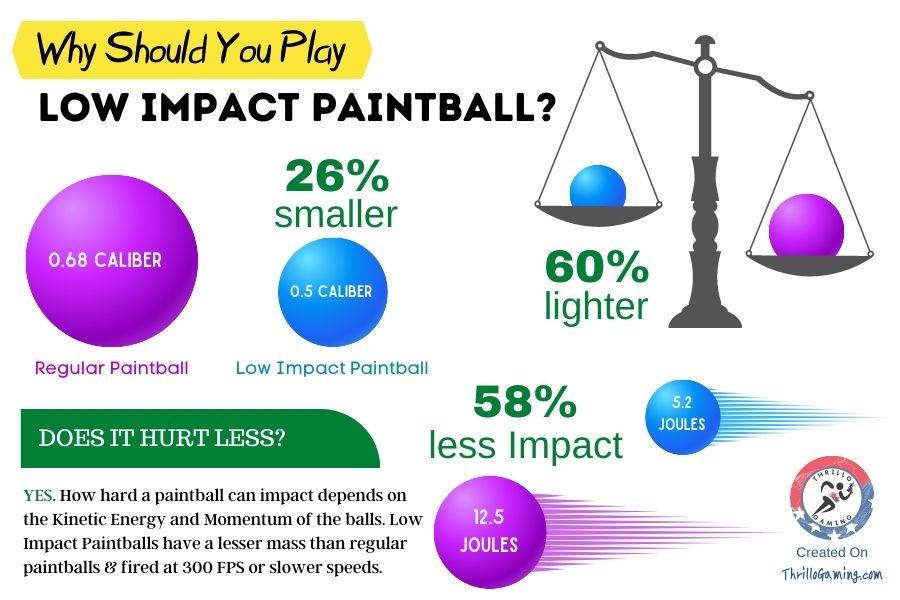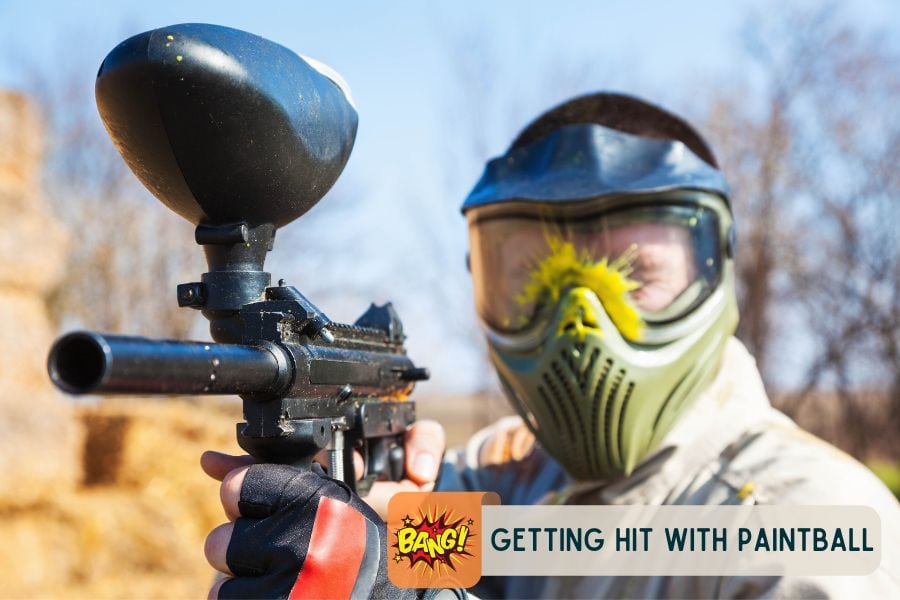Does Paintball Hurt? Pain Factors & Minimizing Stings | Google Discover
Does paintball hurt? The simple answer is yes, a paintball can sting, but the intensity of the sensation depends on a variety of factors, making it a complex question without a single, definitive response.
The world of paintball, a sport that blends strategy, teamwork, and a dash of adrenaline, is often approached with a mixture of excitement and apprehension. For many newcomers, the question of pain looms large. After all, the premise involves being hit by small, gelatinous spheres propelled at significant speeds. Understanding the nuances of this sensation is key to enjoying the sport and minimizing any discomfort.
The core of the matter revolves around the paintball itself. These spherical projectiles, typically measuring around .68 inches in diameter and weighing approximately 3 grams, are substantially larger than airsoft BBs. Upon impact, they can leave behind a stinging sensation, often accompanied by red marks, welts, or bruises. The extent of this impact, however, is not uniform. Several variables contribute to the overall experience, shaping the degree of pain felt by each individual.
- Unveiling Kristi Noem From Bedhead To Bikini Buzz Latest Updates
- Kristi Noem From Cowgirl Outfits To Political Career
Every individual possesses a unique pain threshold. What might register as a minor sting for one person could be considerably more intense for another. This individual variability is a cornerstone of understanding the pain aspect of paintball. Beyond personal tolerance, however, other factors play a critical role in modulating the sensation.
One of the most significant determinants of pain is the distance from which the paintball is fired. The closer the shooter, the greater the impact force, and consequently, the more pronounced the sting. The velocity of the paintball, measured in feet per second (fps), also plays a crucial role. Paintballs are typically propelled at speeds around 285 fps, though this can vary. A higher velocity translates to greater impact and a potentially more painful experience.
Furthermore, the location of the hit on the body matters. Certain areas, where the skin is thinner or more sensitive, are more prone to feeling the brunt of the impact. Bare skin, for instance, is particularly vulnerable. Conversely, areas protected by clothing or gear will naturally absorb some of the impact, reducing the sensation of pain.
- Alice Rosenblum Leaks Latest Updates Exclusive Content
- Xxxtentacion Real Name Life Death What You Should Know
The type of paintball gun used also impacts the experience. Games employing .68 caliber markers or those utilizing paintball soft .50 caliber guns may present different levels of impact and sensation.
Paintball is frequently perceived as a safe and enjoyable pastime, with participants often shooting at friends and relatives without the danger of causing serious injuries. This intense sport, which creates an adrenaline rush, also provides a competitive element, allowing players to engage in strategic gameplay.
For beginners, the sport of paintball can be somewhat intimidating. However, with the right preparation, the experience can be made considerably more pleasant. Protective gear, such as masks, jerseys, and padded vests, can significantly mitigate the pain. Proper gameplay, which includes adhering to safety rules, can further reduce the likelihood of severe impacts. Understanding how to lessen the sting of paintball impacts is essential for an enjoyable game. The use of protective gear can significantly lessen the pain.
The most common question from newcomers is "Does paintball hurt?". The short answer: Yes. Getting hit with a paintball can sting. The degree of pain is comparable to a sharp sting or a strong flick, like being snapped with a rubber band.
The experience is also affected by the individual's mindset. As the level of concern rises, the pain can seem heightened. Focusing on enjoying the game and accepting the possibility of getting hit can, surprisingly, make the pain more manageable.
Is there any paintball that does not cause pain? Paintball games featuring smaller paintballs and alternative equipment provide an excellent opportunity to avoid discomfort, making them suitable for younger players.
In essence, pain in paintball is a multifaceted phenomenon, influenced by physical factors like distance, velocity, and protective gear, as well as psychological elements such as individual pain tolerance and attitude.
The answer to "How much does paintball hurt?" is not fixed; it is a variable. The pain can range from a slight sting, akin to an insect bite, to something more intense. Bare skin is particularly susceptible, with hits often resulting in stings and bruises.
| Feature | Details |
|---|---|
| Sport Name | Paintball |
| Objective | To eliminate opponents by tagging them with paintballs. |
| Primary Equipment | Paintball markers (guns), paintballs, protective masks, protective clothing (optional) |
| Paintball Composition | Gelatin capsules filled with non-toxic, water-soluble paint. |
| Average Paintball Diameter | Approximately 0.68 inches (can vary) |
| Average Paintball Weight | Approximately 3 grams |
| Paintball Velocity | Typically around 285 feet per second (fps), regulated for safety |
| Common Injuries | Stings, welts, bruises. Serious injuries are rare with proper safety equipment and rules. |
| Protective Gear Recommendations | Full-face mask, protective clothing (long sleeves, pants), optional chest protector, gloves. |
| Safety Regulations | Mandatory face protection, barrel covers/plugs when not in play, velocity limits, designated safe zones. |
| Pain Factors | Distance, velocity, body location, individual pain tolerance, protective gear. |
| Game Variations | Speedball, woodsball, scenario games, recreational play |
| Impact on Players | Adrenaline rush, teamwork, strategy, exercise, social interaction |
| References | Paintball Industry Standards (Example) |
The potential for pain should not deter anyone from experiencing the sport. The majority of players find the discomfort to be manageable, especially when compared to the excitement and camaraderie that paintball fosters. As with any physical activity, understanding the risks and taking appropriate precautions can significantly enhance the overall experience. Proper gear, a positive mindset, and a willingness to embrace the fun are key to navigating the minor pain that paintball may bring.
Article Recommendations



Detail Author:
- Name : Prof. Arianna Kuvalis MD
- Username : mayert.humberto
- Email : emard.carolyn@ledner.info
- Birthdate : 1970-02-17
- Address : 746 Gusikowski Turnpike Kundeport, SD 04326-1406
- Phone : 1-678-231-2135
- Company : Keebler, Satterfield and Haley
- Job : Professor
- Bio : Laudantium facere et dolor velit ea quibusdam vel id. Modi quibusdam optio vero voluptas. Est quasi iusto eligendi et veritatis eos iure. Ut quis ut labore deserunt vero.
Socials
linkedin:
- url : https://linkedin.com/in/nathaniel_ondricka
- username : nathaniel_ondricka
- bio : Autem commodi quis id voluptates pariatur.
- followers : 3631
- following : 2317
tiktok:
- url : https://tiktok.com/@ondricka1992
- username : ondricka1992
- bio : Officia reiciendis et harum inventore magnam omnis dolorem.
- followers : 2993
- following : 2334
facebook:
- url : https://facebook.com/ondrickan
- username : ondrickan
- bio : Omnis odio porro placeat. Expedita eligendi quae voluptas aut minus.
- followers : 6176
- following : 876